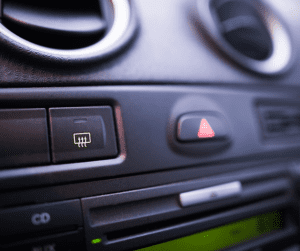
Winter is officially here, and if you live in a cold or rainy climate, you know how frustrating it can be to navigate through the cold weather conditions, especially when it comes to dealing with foggy or frosty windows in your car. Whether it’s frosty mornings or rainy evenings, dealing with fogged-up or frosted windows are not just inconvenient but also a safety hazard. Not only do they impair your vision and increase the risk of accidents, but they also make your car look dirty.
Fortunately, there are some simple and effective ways to defog and defrost your car windows, and prevent them from fogging up or frosting over in the first place. In this article, we will explain the science behind fogging and frosting, and share some tips and tricks on how to defog car windows in winter, how to defrost windshield while driving, how to defog windshield when raining, and more.
The Science of Defogging and Defrosting
1.The Basics of Condensation and Frost
Before diving into practical tips, let’s understand what causes your windows to fog up or frost over It’s all about the temperature difference between the inside and outside of your car, leading to condensation and frost formation. Condensation occurs when warm, moist air comes into contact with a cold surface, such as your windshield or windows. The moisture in the air turns into tiny droplets of water that stick to the glass, creating a foggy layer. Frost forms similarly but under colder conditions. Frost occurs when the temperature outside is below freezing, and the moisture on the glass freezes into tiny crystals of ice, creating a frosty layer.
2. How to Defog Windows in Car in Winter- Effective Defogging Techniques
Defogging windows effectively requires balancing the temperature and humidity inside your vehicle. For this, you will need to turn on both your heat and air conditioner. Start by turning on your heater to warm the air inside. Then, activate the air conditioner to pull moisture out of the air. Ensure your car’s ventilation system is set to draw in fresh air rather than recirculating the interior air. Here are some more tips on how to defog windows in car:
– Turn on the rear defroster. This will help to clear the fog from the back window, which is often overlooked by drivers.
– Use the windshield wipers. This will remove any moisture or dirt that may be contributing to the fogging problem.
– Lower the temperature inside the car. This will reduce the difference between the inside and outside air, which is the main cause of fogging. You can also crack open a window to let some fresh air in, but be careful not to let too much cold air in, as this can make you uncomfortable and reduce your visibility.
– Use a dehumidifier or a desiccant. These are devices that absorb moisture from the air, which can help to prevent fogging. You can buy them online or at auto shops, or you can make your own by filling a sock with cat litter or rice and placing it on the dashboard.
– Apply an anti-fog product. These are sprays or wipes that you can apply to your windows to create a thin layer that prevents fog from forming. You can find them at auto shops or online, but make sure to follow the instructions carefully and test them on a small area first.
3. How to Defog Windshield When Raining- Tackling Fog During Rain
Rainy conditions can quickly lead to fogged windows. To combat this, use your car’s defroster to warm the windshield, and if necessary, slightly open your windows to allow the moist air to escape. Using the air conditioner in conjunction with the heater can also be effective in these situations. Here are some more tips on how to defog windshield when raining:
– Turn on the front defroster. This will send warm air towards the windshield, which will raise its temperature and evaporate the condensation.
– Turn on the rear defroster. This will clear up any fog that may form on the back window due to rain or humidity.
– Turn on the headlights and wipers. This will improve your visibility and help you see through the raindrops on your windshield.
Advanced Techniques for Defrosting and Defogging
1.How to Defrost Windshield While Driving
When you need to defrost your windshield while driving, directing warm, dry air onto the glass is crucial. It’s also helpful to remove any ice or snow from the windshield before you start driving.
If you have frost on your windshield, you need to melt it as quickly as possible. To do this, you need to use both the defroster and the rear window defogger at full blast. The defroster will direct warm air onto your windshield, melting the ice and clearing your view. The rear window defogger will do the same for your rear window, which is also prone to frosting.
Preemptive measures can also help in preventing frost from forming on your windshield in the first place. Before you start driving, you should remove any ice or snow from your windshield using a scraper or a brush. This will reduce the amount of moisture that can freeze on your glass and make it easier to defrost later.
2. Preventive Measures for Defrosting Windows
Prevention is always better than a cure. To prevent frost, consider using a windshield cover overnight or parking your car in a garage to reduce frost formation. For defogging, regularly clean your windows to remove any residue that can attract moisture.
Windshield covers are specially designed to protect your windshield from frost and snow. They are easy to install and remove, and they can save you a lot of time and hassle in the morning. You can find windshield covers online or at auto stores.
Parking in sheltered areas can also help in preventing frost from forming on your windshield. If possible, park your car in a garage or under a roof that blocks direct exposure to cold air and precipitation. This will keep your windshield warmer and drier than if you park outside.
Understanding how to defog car windows in winter and how to defrost windshield while driving is crucial for safe driving. Maintaining clear visibility is vital for safe driving in cold weather. By following these tips and regularly maintaining your vehicle’s heating and air conditioning systems, you can ensure clear visibility in all weather conditions. Regular maintenance of your vehicle’s heating and air conditioning systems is essential during the winter season, so if you face any issues, don’t hesitate to book an appointment or contact us for more advice and assistance.
FAQ
Q: What’s the quickest way to defog windows?
A: The quickest way is to use your car’s heater and air conditioner in tandem, along with ensuring fresh air circulation.
Q: Can I prevent my windows from fogging up?
A: Yes, regular cleaning and using preventive tools like windshield covers can help.
Q: Is it safe to drive with foggy windows?
A: No, it’s unsafe. Always ensure your windows are clear before driving.
Q: Can air conditioning help in winter for defogging?
A: Yes, air conditioning can remove moisture from the air, helping to defog your windows.
Remember, these tips are not just about comfort but essential for your safety on the road during cold weather conditions.
